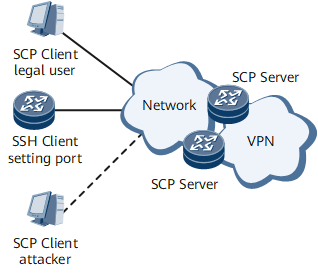Support for SCP
The Secure Copy Protocol (SCP) is derived from Secure Shell version 2 (SSH2.0). A user on an SCP client must enter a correct user name, password, and private key for authentication before establishing a connection with an SCP server. After being authenticated, the client can remotely manage file transfer using SCP. The system encrypts user data using a negotiated session key.
An attacker does not have the correct private key or password and therefore fails to be authenticated. In addition, the attacker cannot decrypt data or obtain a session key even though the attacker intercepts data exchanged between clients and the server. Only specified clients and the server can decrypt data exchanged between one another, ensuring secure data transmission on the network.
Devices support the following SCP functions:
Support for both SCP client and server functions
The device can function as either an SCP server or an SCP client that accesses other SCP servers.
Enabling or disabling of the SCP server function (disabled by default)
Disable the SCP server function if you do not need it. This function is configured globally.
Supports client and server using the transparent file system. For all file operations, a unified file system is used to access files on remote boards.
Support for recursive transfer of multiple files
For example, a directory contains multiple files and sub-directories. SCP can be used to transfer all files in the directory in a batch without changing the hierarchical directory structure.
